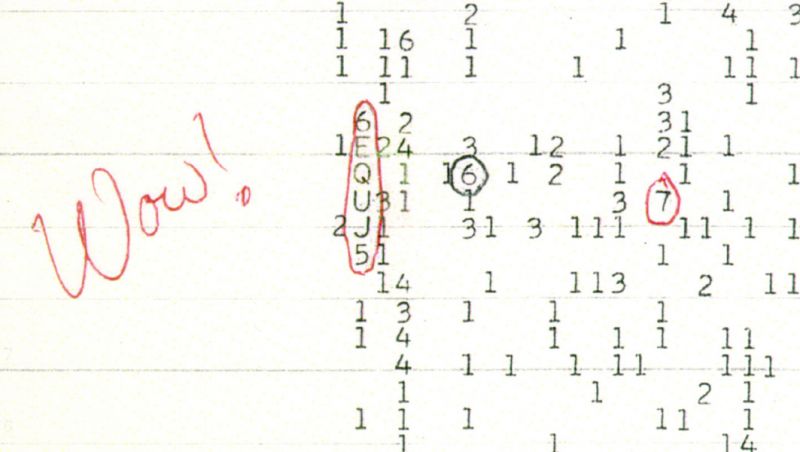Alien hunters recap the most exciting developments of the year

When news broke that scientists had detected a signal when their antennas were aimed at Proxima Centauri, many thought we had finally found evidence of intelligent life beyond Earth.
Turns out, the signal is easily explainable as terrestrial interference and didn’t come from E.T. Still, 2021 has been full of exciting developments in the search for life beyond Earth. From better understanding the origin of life to exploring potentially habitable worlds of our solar system, here are the SETI highlights of the year.
Complex molecules associated with life spotted in space
For the first time, scientists found complex carbon-bearing molecules critical to the development of life in space. Scientists have long believed that these molecules are abundant in the universe, and in March, the Green Bank Telescope in West Virginia detected the first definitive radio signatures from them.
Alessandra Ricca, SETI Institute researcher, is working on a database of infrared signals from these complex molecules for future observations using the James Webb Space Telescope, to be launched in December. Further research will help humans understand how life originates and the conditions it needs to thrive throughout the universe.
Perseverance Rover gets to work – what clues about life do its samples hold?
NASA’s Perseverance Rover, Percy to friends, made a nail-biting landing in Mars’ Jezero Crater on February 18, 2021. The Red Planet is of enormous interest to astrobiologists and to SETI because the planet may have once been warmer and wetter and thus habitable. Understanding whether life ever existed on Mars will help humans understand more about how life originated on Earth and, possibly, on other planets.
Percy successfully cached its first sample of Martian rock, which will be returned to Earth in an upcoming mission. It also made images suggesting Jezero Crater had experienced past flooding, further advancing the idea that it was once a lake.
And, of course, we can’t forget the little helicopter that could, Ingenuity, which hitched a ride to Mars with Percy. Ingenuity became the first aircraft to complete a controlled flight on a planet beyond Earth. The helicopter’s success will help future missions understand how best to use an aircraft as a scout for interesting exploration sites.
Allen Telescope Array detects FRB
In June, the team at the Allen Telescope array announced an observation of a bright double-peaked Fast Radio Burst (FRB) from the repeating source known as FRB20201124A. This observation was the first FRB detected with the ATA, which has been undergoing extensive upgrades for both its receivers and digital signal processing hardware.
This detection demonstrates the sensitivity of the ATA’s instrumentation and its abilities to detect a radio signal of interest in the search for advanced societies beyond Earth.
Additionally, Dr. Sofia Sheikh, an astronomer and physicist, has been awarded a Postdoctoral Research Fellowship at the ATA to focus on FRBs and develop improved SETI detection methods. She will also mentor underrepresented students in physics and astronomy. Read more about these exciting updates here and here.
U.S. Government issues inconclusive report on UAPs
In June, the U.S. government issued its highly anticipated preliminary report on Unidentified Ariel Phenomenon (UAPs). The report concluded that most UAPs can’t be understood fully due to limited data but says nothing about a possible extraterrestrial source for these incidents.
This report, and the buzz surrounding it, raise important questions for the SETI community, primarily are UAPs worthy of deeper scientific study and if so, how do we do it? Researchers at Harvard University, the SETI Institute, and the broader community are working on answers to these questions.
Dual Missions to Venus will shine a light on Earth’s twin
In June, NASA announced two missions to Venus: DAVINCI+ (Deep Atmosphere Venus Investigation of Noble gases, Chemistry, and Imaging) and VERITAS (Venus Emissivity, Radio Science, InSAR, Topography, and Spectroscopy). These will be the first NASA missions to Venus, often referred to as Earth’s twin, since 1990, and will increase our understanding of the planet and its evolution. This information will help SETI scientists better characterize habitable zones around stars and climate change on planets.
DAVINCI+ will send a probe into Venus’ atmosphere to better determine its composition at various altitudes and take images of Venus’ “tesserae,” land masses akin to Earth’s continents. David Grinspoon, a member of the SETI Institute’s Science Advisory Board, is a key investigator on this mission.
VERITAS is an orbiter that will better map the planet’s surface, identify rock types on the surface, and determine if active volcanoes are releasing water vapor or phosphine into the atmosphere.
Ganymede has water vapor, could it have life?
Planets aren’t the only type of world that could sustain life; Several of the moons of Jupiter and Saturn have been particularly interesting to astrobiologists. And scientists studying Hubble images have found evidence that water vapor exists in the atmosphere of Jupiter’s moon Ganymede. Since water is essential to life on Earth, this discovery will prompt further study of this moon.
A new class of exoplanets to study
A group of scientists identified a new class of exoplanets, Hycean (hydrogen-ocean) worlds, which are covered with oceans and boast hydrogen-rich atmospheres. These planets are numerous and, thanks to their size, easier to find than small, rocky, Earth-like planets. They are also thought to be quite warm, making it possible for microbial life to thrive beneath their surface.
With the launch of the James Webb Telescope, researchers are hoping to learn more about these interesting candidates for life beyond Earth.
Laser SETI begins installation in Hawaii
While the ATA searches the skies for radio signals, LaserSETI will examine star systems for laser flashes that could indicate the presence of an advanced civilization. In late September, the SETI Institute’s Eliot Guillum began setting up the latest LaserSETI hardware in Haleakala, Hawaii.
Signals for Proxima Centauri aren’t from aliens
Shortly before Halloween, researchers published two papers analyzing the signal detected in 2019 by Breakthrough Listen. The signal appeared to originate near Proxima Centauri and generated significant buzz when it was first announced.
After additional research, SETI scientists concluded the signal most likely didn’t come from aliens but rather malfunctioning equipment on Earth. Dr. Andrew Siemion contributed to both papers and Dr. Sofia Sheikh, who will join the team at the Allen Telescope Array team in January, was the lead author on one.





